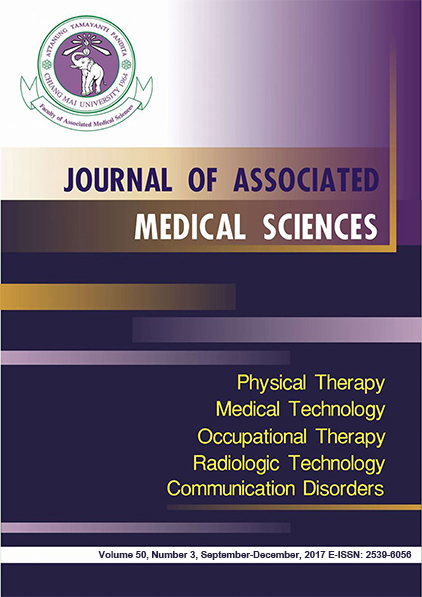The relationship between metabolite from 1H-MRS and brain volume by magnetic resonance technique in methamphetamine users
Main Article Content
Abstract
Background: Methamphetamine (MA) is a highly addictive stimulant causes neurotoxicity. Changes of brain metabolites and brain volumes in MA abusers have been documented. However, the relationship between changes of brain metabolites at a selected brain location and changes of brain volumes at the same location has never been reported.
Objectives: To explore the relationship between brain metabolites and brain volumes from the same locations in MA users.
Materials and methods: Ten MA users and 14 Healthy control (HC). For the brain volumes, T1-weighted high resolution images were acquired using 3D FFE pulse sequence. FreeSurfer version 5.3 was applied for brain volumes analysis. Single voxel MRS was acquired in 4 voxel locations and using PRESS pulse sequence for scanning. TARQUIN version 4.3.5 was applied for brain metabolites. Pearson correlations was used to analyze the correlation between brain metabolites and brain volumes in MA users.
Results: MA users showed significantly reduced NAA (p=0.023) and NAA/Cho (p=0.05) in left FWM, compared with HC group. In left BG region, MA user group showed significantly reduced NAA/Cho (p=0.042) and increased Cho (p=0.05), compared with HC group. MA user group showed significantly reduced FGM volume (p=0.043). For the analysis of relationship between metabolites and brain volume, it was found that there are significant correlations between reducing of NAA at FGM region and FGM volume (n=10, r=0.635, p=0.049), and significant negative correlations between reducing of Cr at PGM region and OGM volume (n=10, r= -0.741, p=0.022).
Conclusion: Significant correlations between brain metabolites and brain volumes at FGM and PGM regions.
Article Details
Personal views expressed by the contributors in their articles are not necessarily those of the Journal of Associated Medical Sciences, Faculty of Associated Medical Sciences, Chiang Mai University.
References
2. Goldstein RZ, Volkow ND. Drug addiction and its underlying neurobiological basis: neuroimaging evidence for the involvement of the frontal cortex. Am J Psychiatry. 2002;159(10):1642-52.
3. Henry BL, Minassian A, Perry W. Effect of methamphetamine dependence on everyday functional ability. Addict Behav. 2010;35(6):593-8.
4. Krasnova IN, Cadet JL. Methamphetamine toxicity and messengers of death. Brain Res Rev. 2009;60(2):379-407.
5. Ernst T, Chang L, Leonido-Yee M, Speck O. Evidence for long-term neurotoxicity associated with methamphetamine abuse: A 1H MRS study. Neurology. 2000;54(6):1344-9.
6. Nordahl TE, Salo R, Natsuaki Y, Galloway GP, Waters C, Moore CD, et al. Methamphetamine users in sustained abstinence: a proton magnetic resonance spectroscopy study. Arch Gen Psychiatry. 2005;62(4):444-52.
7. Chang L, Ernst T, Speck O, Grob CS. Additive effects of HIV and chronic methamphetamine use on brain metabolite abnormalities. Am J Psychiatry. 2005;162(2):361-9.
8. Thompson PM, Hayashi KM, Simon SL, Geaga JA, Hong MS, Sui Y, et al. Structural abnormalities in the brains of human subjects who use methamphetamine. J Neurosci. 2004;24(26):6028-36.
9. Daumann J, Koester P, Becker B, Wagner D, Imperati D, Gouzoulis-Mayfrank E, et al. Medial prefrontal gray matter volume reductions in users of amphetamine-type stimulants revealed by combined tract-based spatial statistics and voxel-based morphometry. Neuroimage. 2011;54(2):794-801.
10. Chang L, Smith LM, LoPresti C, Yonekura ML, Kuo J, Walot I, et al. Smaller subcortical volumes and cognitive deficits in children with prenatal methamphetamine exposure. Psychiatry Res. 2004;132(2):95-106.
11. Sailasuta N, Abulseoud O, Hernandez M, Haghani P, Ross BD. Metabolic Abnormalities in Abstinent Methamphetamine Dependent Subjects. Subst Abuse. 2010;2010(4):9-20.
12. Rigotti DJ, Inglese M, Gonen O. Whole-brain N-acetylaspartate as a surrogate marker of neuronal damage in diffuse neurologic disorders. AJNR Am J Neuroradiol. 2007;28(10):1843-9.
13. Schlaepfer TE, Lancaster E, Heidbreder R, Strain EC, Kosel M, Fisch HU, et al. Decreased frontal white-matter volume in chronic substance abuse. Int J Neuropsychopharmacol. 2006;9(2):147-53.
14. Soares DP, Law M. Magnetic resonance spectroscopy of the brain: review of metabolites and clinical applications. Clin Radiol. 2009;64(1):12-21.
15. Fernandes NC, Sriram U, Gofman L, Cenna JM, Ramirez SH, Potula R. Methamphetamine alters microglial immune function through P2X7R signaling. J Neuroinflammation. 2016;13(1):91.
16. Sekine Y, Minabe Y, Kawai M, Suzuki K, Iyo M, Isoda H, et al. Metabolite alterations in basal ganglia associated with methamphetamine-related psychiatric symptoms. A proton MRS study. Neuropsychopharmacology. 2002;27(3):453-61.
17. Kim SJ, Lyoo IK, Hwang J, Chung A, Hoon Sung Y, Kim J, et al. Prefrontal grey-matter changes in short-term and long-term abstinent methamphetamine abusers. Int J Neuropsychopharmacol. 2006;9(2):221-8.
18. Ian F. Difference Between Grey and White Matter [Internet]. [Place unknown]: DifferenceBetween.net; 2010 [cited 2016 November 17]. Available from: http://www.differencebetween.net/science/health/difference-between-grey-and-white-matter/.


